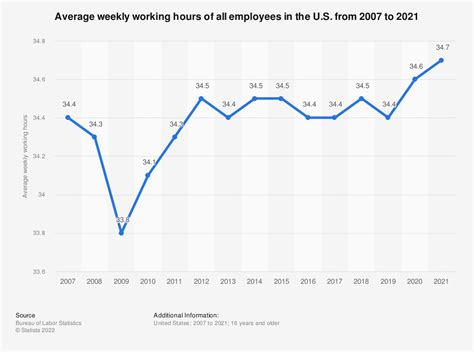Average Weekly Work Hours In The Us: A Statistical Overview

In today’s fast-paced world, people are working longer hours than ever before. With the rise of the gig economy and the increasing demand for work-life balance, it’s important to understand the average weekly work hours in the US. In this article, we’ll explore the statistics and trends surrounding work hours in America.
What are the average weekly work hours in the US?
The average weekly work hours in the US vary depending on a number of factors, including industry, occupation, and location. However, according to the Bureau of Labor Statistics (BLS), the average weekly work hours for all employed persons in the US is 34.9 hours.
Industry and occupation
The average weekly work hours can vary greatly by industry and occupation. For example, workers in the manufacturing industry typically work longer hours than those in the retail industry. Additionally, managers and professionals typically work longer hours than administrative support workers.
According to the BLS, the average weekly work hours by industry are as follows:
- Manufacturing: 40.7 hours
- Construction: 39.6 hours
- Wholesale trade: 38.9 hours
- Transportation and warehousing: 37.8 hours
- Retail trade: 30.8 hours
The average weekly work hours by occupation are as follows:
- Managers: 44.0 hours
- Professionals: 42.3 hours
- Administrative support: 35.3 hours
- Service: 30.1 hours
Location
The average weekly work hours can also vary by location. For example, workers in the Northeastern US typically work longer hours than those in the Western US. Additionally, workers in urban areas typically work longer hours than those in rural areas.
According to the BLS, the average weekly work hours by region are as follows:
- Northeast: 36.3 hours
- Midwest: 34.7 hours
- South: 34.5 hours
- West: 34.3 hours
Why are work hours important?
Work hours are important because they can have a significant impact on a person’s physical and mental health. Working long hours can lead to fatigue, stress, and burnout, which can in turn lead to a variety of health problems. Additionally, long work hours can have a negative impact on family life and personal relationships.
On the other hand, working fewer hours can have its own set of challenges. For example, workers in the gig economy may struggle to make ends meet if they are not able to secure enough work hours.
What are the trends in work hours?
Over the past few decades, there has been a trend towards shorter work hours in the US. In the early 1900s, it was common for workers to put in 60 or more hours per week. However, with the introduction of labor laws and regulations, work hours began to decrease.
Today, many companies are offering flexible work arrangements, such as telecommuting and job sharing, which can help employees achieve a better work-life balance. Additionally, the rise of the gig economy has led to more people working for themselves, which can allow for more control over work hours.
Conclusion
The average weekly work hours in the US vary widely depending on factors such as industry, occupation, and location. While there has been a trend towards shorter work hours in recent years, it’s important to understand the impact that work hours can have on a person’s health and well-being.
FAQs
1. What is considered full-time work in the US?
Full-time work is typically considered to be 35 or more hours per week.
2. What is the maximum number of hours a person can work per week in the US?
The Fair Labor Standards Act (FLSA) does not limit the number of hours that an employee can work per week. However, it does require that employees be paid overtime for any hours worked over 40 in a week.
3. What are the benefits of working fewer hours?
Working fewer hours can lead to improved physical and mental health, as well as better work-life balance. Additionally, it can allow for more time to pursue hobbies and spend time with family and friends.
4. What are the drawbacks of working fewer hours?
Working fewer hours can lead to financial insecurity, particularly for workers in the gig economy or those who are paid hourly. Additionally, it can limit career advancement opportunities.
5. How can employers help employees achieve a better work-life balance?
Employers can offer flexible work arrangements, such as telecommuting and job sharing, as well as paid time off and other benefits that support work-life balance.
